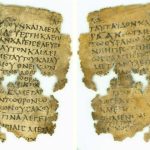| Artefact ID | 366 |
| TM ID | TM 61643 |
| Findspot (DEChriM ID) | 28 (al-Bahnasā) | Class | Textual |
| Material | Parchment |
| Writing medium | Codex |
| Text content | Literary |
| Language | Greek |
| Description | P.Oxy. VIII 1080; Gregory-Aland 0169; 0169; Uncial 0169 The fragment is a well preserved folio from a miniature codex containing the Book of Revelation verses 3:19b–4:3a. A small piece of parchment was lost from its upper left corner subsequent to its initial publication and is still missing; see Malik 2017: 310. The codex is one of three early miniature codices containing the Apocalypse; see also P.Oxy. VI 848 and P.Oxy. LXVI 4500, and it seems to agree most frequently with the Codex Alexandrinus and the Koine MSS rather than with the Sinaiticus (contrary to previous comparisons); see Malik 2017: 313. The codex appears to have contained only the Book of Revelations on account of its medium-sized text combined with its small format and the preserved pagination in the upper outer corner of the folio (marking the pages as p. 33 and p. 34); see ed. pr. The text was written in slightly ornamental uncials and contains rough breathings, diaereses and some instances of ellision and diastole (see l. 6, 21-22); punctuation is indicated by spaces, as well as an ekthesis in l. 25; see Blumell / Wayment 2015: 182. The scribe appears to have added l. 15 and 16 to the bottom of the column on the recto at a later time to supplement an omission in l. 3 (which is indicated by an appropriate sign of error). Several other corrections and retouchings have been performed by a later scribe (i.e., a corrector), and a correction worthy of special note can be found in l. 30 where the corrector has introduced an unattested reading; see Malik 2017: 312. In addition to ordinary textual inaccuracies, Malik posits that the original text contains at least three (perhaps 5) otherwise unattested variants (see l. 10, 26, 29 and 30, as well as a change of tense in l. 9). |
| Selection criteria | Literary genre (Biblical), Nomina sacra |
| Date from | 300 |
| Date to | 399 |
| Dating criteria | Palaeography.
|
| Absolute/relative date | Relative date |
| Archaeological context | Excavated in Oxyrhynchus in 1906 and subsequently donated to the Princeton Theological Seminary Library in 1915 through the agency of William Park Armstrong, the Professor of the New Testament Literature at the Princeton Seminary; see Malik 2017: 310. |
| Accession number | Princeton, Theological Seminary, P. 5. |
ARTEFACT IDENTIFIERS
Reference edition:
• Malik, Peter. 2017. "P.Oxy. VIII 1080. A Fresh Edition and Textual Notes on a Miniature Codex of the Apocalypse". Archiv für Papyrusforschung und verwandte Gebiete 63 (2). 310-320.
Editio princeps:
• Hunt, Arthur S. 1911. The Oxyrhynchus Papyri, part VIII. Published by the Egypt Exploration Society in Graeco-Roman Memoirs. London. 14-16, no. 1080 and plate no. 1.
Additional bibliography:
• Blumell, Lincoln H. and Thomas A. Wayment. 2015. Christian Oxyrynchus: Texts, Documents and Sources. Waco, Texas. Papyrus no. 46.
• Clarysse, Willy and Pasquale Orsini. 2012. "Early new testament manuscripts and their dates: A critique of theological palaeography". Ephemerides Theologicae Lovanienses 88. 443-474.
• Gamble, Harry Y. 1995. Books and Readers in the Early Church: A History of Early Christian Texts. New Haven, Conn.: Yale Univ. Press. 236.
• Jaroš, Karl. 2006. Das Neue Testament nach den ältesten griechischen Handschriften (CD-Rom). 4612-4618, no. 2.60.
• Kruger, Michael J. 2013. "Manuscripts, Scribes, and Book Production within Early Christianity". Christian Origins and Greco-Roman Culture. Porter, s. E. and A. W. Pitts, eds. Leiden: Brill. 15-40.
• Malik, Peter. 2018. "The Greek Text of Revelation in Late Antique Egypt: Materials, Texts, and Social History." Zeitschrift Für Antikes Christentum 22 (3). 414-415.
• Metzger, Bruce Manning. 1981. Manuscripts of the Greek Bible: An Introduction to Greek Palaeography. New York: Oxford University Press. 72-73.
• Nicklas, Tobias. 2012. "The Early Text of Revelation". The Early Text of the New Testament. Hill, Charles E. and Michael J. Kruger, eds. 236.
• van Haelst, Joseph. 1976. Catalogue des papyrus littéraires juifs et chrétiens. Description no. 561


 Json data
Json data




